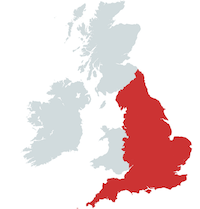
Map by mapchart.net - Some rights reserved.
Location
Holy Island, Northumberland, England
Description
Lindisfarne Castle sits on the rocky Holy Island or Lindisfarne in the North Sea, 71 miles south of Edinburgh on the English/Scottish border. The island is only accessible at low tide via a three mile causeway.
The small castle is accessed via a steep cobbled pathway and is built over two storeys of a light colored stone. Inside the renovated castle the remains of a Tudor fort are still visible; the rest of the castle has been decorated in an Arts and Crafts style.
Facilities
The castle is open from the middle of March until the end of October, except Monday. Due to the nature of the tides opening times vary but usually between 10am and 3pm, the gardens are open all year round until 5pm.
Parking is available nearby with a walk of approximately 1 mile to the castle which has its own shop selling local jams, honey, biscuits and cakes.
The castle also offers a holiday cottage sleeping two people for short breaks and is licensed for civil wedding ceremonies. Ceremonies take place on a Monday during the open season with the barrel vaulted 'Ship Room' being the place most couples choose to tie the knot, suitable for up to 30 guests. Other options include the long gallery with its stone arches for up to 12 people or the upper gallery; the highest part of the castle with a bay window looking over the harbor and village for up to 10 people.
From May until August specialist garden talks are given monthly.
History
A small fort was built on the site in 1550 with stones from the disused Lindisfarne Priory. In 1570 a stronger Norman fortification was started on Beblowe Crag as the site was constantly under attack from both the Norsemen and the Scotts.
Henry VIII used the castle for a time and when he left, his troops it as a store. Elizabeth I added gun platforms and strengthened the castle during her reign, and following the succession of King James to the throne in 1603; and the combination of the English and Scottish monarchy, the need for a defensive castle declined and the castle was used as a coastguard lookout station.
In 1901 the property was restored and decorated by the designer Edwin Lutyens for Edward Hudson; of Country Life magazine, as a holiday home and between 1906 and 1912 the castle's vegetable plot was transformed into a beautiful garden by Gertrude Jekyll. In 1944 the National Trust took over the running of the castle and gardens and has renovated three of the large herring fishing boats which had been used as sheds.
The Arts
The film 'The tragedy of Macbeth' (1971) by Roman Polanski was filmed at the castle.
Other Castles in the Area
Bamburgh Castle, Northumberland
Chillingham Castle, Northumberland
Dunstanburgh Castle, Northumberland
Etal Castle, Northumberland
Norham Castle, Northumberland
Hutton Castle, Scottish Borders
|
|
|
|

